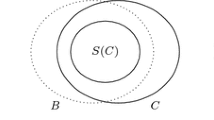Abstract
A recurring theme in the mathematical social sciences is how to select the “most desirable” elements given a binary dominance relation on a set of alternatives. Schwartz’s tournament equilibrium set (TEQ) ranks among the most intriguing, but also among the most enigmatic, tournament solutions proposed so far. Due to its unwieldy recursive definition, little is known about TEQ. In particular, its monotonicity remains an open problem to date. Yet, if TEQ were to satisfy monotonicity, it would be a very attractive solution concept refining both the Banks set and Dutta’s minimal covering set. We show that the problem of deciding whether a given alternative is contained in TEQ is NP-hard, and thus does not admit a polynomial-time algorithm unless P equals NP. Furthermore, we propose a heuristic that significantly outperforms the naive algorithm for computing TEQ.
Similar content being viewed by others
References
Alon N (2006) Ranking tournaments. SIAM J Discret Math 20(1): 137–142
Banks JS (1985) Sophisticated voting outcomes and agenda control. Soc Choice Welf 3: 295–306
Bouyssou D, Marchant T, Pirlot M, Tsoukiàs A, Vincke P (2006) Evaluation and decision models: stepping stones for the analyst. Springer, Berlin
Brandt F, Fischer F (2008) Computing the minimal covering set. Math Soc Sci 56(2): 254–268
Brandt F, Harrenstein P (2009) Characterization of dominance relations in finite coalitional games. Theory Decis (to appear)
Brandt F, Fischer F, Harrenstein P (2009) The computational complexity of choice sets. Math Log Q 55(4): 444–459
Conitzer V (2006) Computing Slater rankings using similarities among candidates. In: Proceedings of the 21st national conference on artificial intelligence (AAAI). AAAI Press, pp 613–619
Condorcet Marquis de Essai sur l’application de l’analyse à la probabilité des décisions rendues à la pluralité des voix. Imprimerie Royale, 1785. Facsimile published in 1972. Chelsea, New York
Dung PM (1995) On the acceptability of arguments and its fundamental role in nonmonotonic reasoning, logic programming and n-person games. Artif Intell 77: 321–357
Dunne PE (2007) Computational properties of argumentation systems satisfying graph-theoretic constraints. Artif Intell 171(10-15): 701–729
Dutta B (1990) On the tournament equilibrium set. Soc Choice Welf 7(4): 381–383
Dutta B, Laslier J-F (1999) Comparison functions and choice correspondences. Soc Choice Welf 16(4): 513–532
Fishburn PC (1977) Condorcet social choice functions. SIAM J Appl Math 33(3): 469–489
Fisher DC, Ryan J (1995) Tournament games and positive tournaments. J Graph Theory 19(2): 217–236
Gillies DB (1959) Solutions to general non-zero-sum games. In: Tucker AW, Luce RD (eds) Contributions to the Theory of Games IV, vol 40. Annals of Mathematics Studies. Princeton University Press, New Jersy, pp 47–85
Houy N (2009) Still more on the tournament equilibrium set. Soc Choice Welf 32: 93–99
Laffond G, Laslier J-F, Le Breton M (1993) More on the tournament equilibrium set. Math Sci Hum 31(123): 37–44
Laffond G, Laslier J-F, Le Breton M (1993) The bipartisan set of a tournament game. Games Econ Behav 5: 182–201
Laslier J-F (1997) Tournament solutions and majority voting. Springer, Berlin
Papadimitriou CH (1994) Computational complexity. Addison-Wesley, Reading
Schwartz T (1990) Cyclic tournaments and cooperative majority voting: A solution. Soc Choice Welf 7: 19–29
Stearns R (1959) The voting problem. Am Math Mon 66(9): 761–763
Tarjan R (1972) Depth-first search and linear graph algorithms. SIAM J Comput 1(2): 146–160
Woeginger GJ (2003) Banks winners in tournaments are difficult to recognize. Soc Choice Welf 20: 523–528
Author information
Authors and Affiliations
Corresponding author
Rights and permissions
About this article
Cite this article
Brandt, F., Fischer, F., Harrenstein, P. et al. A computational analysis of the tournament equilibrium set. Soc Choice Welf 34, 597–609 (2010). https://doi.org/10.1007/s00355-009-0419-z
Received:
Accepted:
Published:
Issue Date:
DOI: https://doi.org/10.1007/s00355-009-0419-z




